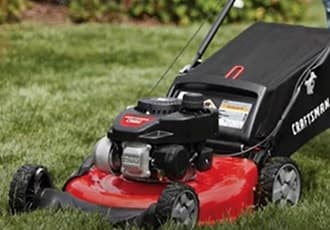As an Amazon Associate, this site earns commissions from qualifying purchases. For more information click here.
Some call it pulsing or surging, others refer to it as the engine revving up and down. No matter what it’s called, you can tell there is a problem. Before you go to a service repair center, I suggest you take a look at the following solutions. You might be surprised how easy engine rev issues can be fixed.
A clogged fuel filter or a defective spark plug are the most likely causes. If cleaning or replacing both does not solve the problem, the carburetor might require adjustment or replacement.
Without further ado let’s examine the causes and solutions.
Defective Fuel Filter
In most cases, lawn mower revving problems are caused by a dirty or damaged fuel filter. Cleaning or better yet replacing it usually fixes the problem.
If an engine pulses, it’s likely due to a fuel issue. Fuel filters prevent contaminants from flowing into the engine. If the filter is dirty, it won’t be able to keep these particles out. Clogging also limits the amount of fuel that goes in the engine.
Solution. Some fuel filters are reusable, but they’re also easy to replace if needed. If the filter isn’t too dirty, cleaning could work. But if it’s covered with deposit and grime, it’s time for a replacement.
Lawn mower fuel filters are widely available. The Coco Mocart fuel filter works with many popular brands for instance. Check your manual or the manufacture website for any specific fuel filters that they recommend.
Fuel Issues
There are a lot of issues that can affect lawn mower engine fuel. Any of these can cause it to rev up and down.
Dirty fuel. Dirt and other particles can cause serious engine damage, which is why lawn mowers have fuel filters. If the filter is dirty, contaminated fuel will make its way into the engine and cause it to surge.
Old fuel. Lawn mower fuel should be replaced every 30 days because left sitting for too long, it will god bad. Putting fuel stabilizer like Stabil helps too. But I make it a habit to change oil every month.
Wrong mix. Modern lawn mowers are 4-stroke and store oil and gas separately. But if you own an older, 2-stroke model, you have to combine the gas and oil correctly. If you made a mistake with the mix, discard the fuel and prepare a new mix.
The ratio is usually 40:1 50:1 or 32:1. Check the manual because the ratio has to be exact. If you make an error this can precipitate surging.

Too little fuel. If you’ve been mowing for a while, fuel will run low at some point. If it drops below critical level, the revs will surge and pulse. Use the dipstick as a guide and add more fuel.
Faulty fuel regulator. As you probably guessed, the fuel regulator manages fuel flow to the engine. If this stops working, the lawn mower will cease working. A damaged fuel regulator needs to be replaced.
Related. Can lawn mowers start without oil
Clogged Tank Cap
Lawn mower fuel tanks have a small opening for aeration purposes. This orifice is essential for fuel to flow into the carburetor.. If the hole gets clogged with dirt or rainwater, fuel cannot reach the carburetor.
Solution. Turn off your lawn mower and take out the gas cap. Clean the cap thoroughly. It’s a good idea to inspect the fuel tank and clean it too. Use a fuel cleaner like Ultra 5 to get rid of impurities. Try the lawn mower again and it should run fine.
I recommend you drain the tank and clean it as well. If the gas cap is dirty, chances are the rest of the tank is too. Empty the tank, clean and pour fresh fuel.
Worn Spark Plug
Dirty or damaged spark plugs can cause lawn mowers to rev up and down. Because they play an important role in the engine, you should attend to any spark plug problems immediately.
Solution. Check the connection. The spark plug might be just loose. Next, check for signs of dirt or carbon deposit. Make certain the spark plug gap is correct and it isn’t bent or warped.
If there is dirt, soot or corrosion, you can clean the spark plug or replace it. If it’s just s bit of dirt, use a brush to wipe it off. But if it’s caked with soot, get a new spark plug.
One thing I want to note: spark plugs look alike but they’re not the same. Your lawn mower needs a specific type of spark plug to work. You can find the specs needed in the manual or the manufacturer site.
Ignition system. The ignition produces the voltage the spark plug uses, so if there’s damage here the spark plug won’t work. I recommend inspecting these at the same time you check the spark plug.
Carburetor Needs Adjustment
There are two things you can adjust on the carburetor, the idle speed and the air to fuel mixture. The adjustment screws have labels for easy reference.
Turn the adjustment screws incrementally and listen to the engine. Keep making small adjustments until the revs are normal.
The slightest adjustment is going to have a major effect on the idle speed and fuel mixture. That’s why I suggest you make incremental changes. Turn the screw a little and listen to the engine. If it still surges, adjust again. Keep doing this until the engine sound is just right.
Carburetor Needs Cleanup
Most people clean the carburetor first before making adjustments. If yours is covered with soot I suggest you do the same.
First you have to take off the air filter cover to gain access to the carburetor. Take the carburetor out and start cleaning. There are plenty of options available such as the Ultrasonic cleaning solution.
Look for signs of damage too. If some parts need replacement, get a carburetor rebuild kit. Consult the manual or manufacturer website for more details on what rebuild kit is needed.
Cleaning a carburetor requires disassembly. To make things easier, arrange each piece you remove side by side so you can put them back in the reverse order you took them out.
If you have an old lawn mower, the carburetor probably has some worn out parts. It’s a good idea to have a rebuild kit in case you need to replace something.
Dirty Air Filter
Air filters keep the interior dust free and helps the engine cool down. It’s a standard feature in lawn mowers and other garden power tools because it is essential. As time passes, the filter gets covered by dirt, dust, grass clippings etc.
Solution. It depends on what type of air filter your lawn mower has. Paper air filters cannot be reused. Once covered with dirt or damaged, you have to replace it.
Foam air filters are washable. Place it under running water or leave in a bucket of soapy water for a few minutes. If it’s just light dirt you can wipe it with a brush. You’ll have to replace it though if there is damage.
Broken Valve
This is often overlooked in cases of lawn mower engines that rev up and down. But a damaged valve can be one of the causes.
Valves control the exhaust fumes that come out of the engine and the fuel vapor that enters the combustion chamber.
Valves get clogged with dirt through heavy use, which will affect engine power. Valves also develop cracks due to wear and tear.
Broken valves have to be replaced. But if it is still intact, it might just need some adjustments. If it’s covered with carbon deposit, you’ll need to clean it.
Disconnect the air injector and the throttle. Adjust the idle speed slowly. Next, pour throttle cleaning solution in the choke throat.
Let the cleaner sit there for 5 minutes then turn on the engine. If this doesn’t work, you have to remove the valve and clean it thoroughly. Replace the valve if it is damaged.

I love the outdoors and all the tools for maintaining gardens, yards and lawns. The only thing I am more passionate about is sharing what I know about garden and outdoor equipment.


